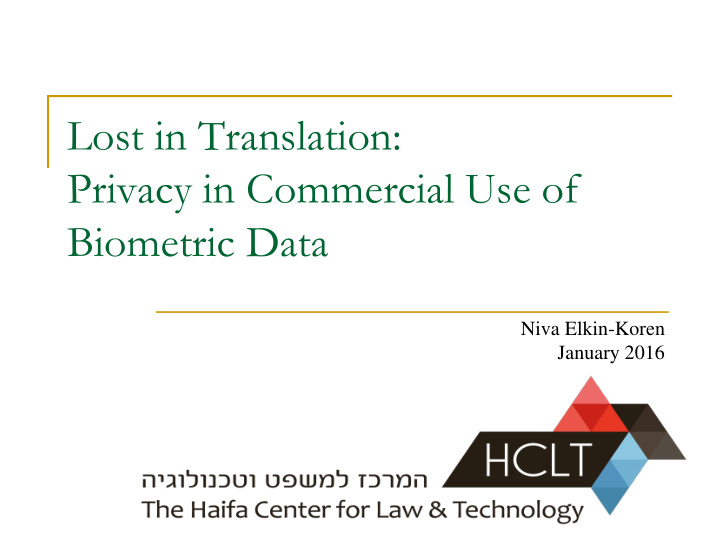



Lost in Translation: Privacy in Commercial Use of Biometric Data Niva Elkin-Koren January 2016
Outline • The Law and Technology Paradigm • Information Privacy • Privacy in commercial use of biometric data
The Law and Technology Paradigm Law Legal response Society Technology
Gun Control?
The Law and Technology Paradigm Law Legal response Social norms Technology
The Law and Technology Paradigm Law Reflects social norms Social norms Technology
The Law and Technology Paradigm Law Shapes social norms Society Technology
The Law and Technology Paradigm Law Society Technology Technological determinism
Jan 2012 SOPA Blackout Stop Online Piracy Act
The Law and Technology Paradigm Law Society Technology Social construction
Technology • Technological determinism • Social construction of technology • Science, Technology and Society (STS) – How social, political and cultural values affect technological innovation – How technological developments affect society, politics and culture
The Law and Technology Paradigm Law Legal response Law shapes Technology Society Technology
Law Shapes Technology Intellectual property laws Restrictions on R&D Liability rules
Code as Law
Lessig ’ s Code 2.0
Law and Technology • The law responds to technological challenges • The law shapes new technologies • Technology substitutes for law
BIOMETRIC DATA FOR COMMERCIAL PURPOSE
Facebook ’ s ecosystem
The Law and Technology Paradigm Law Social norms Technology
What is informational privacy? a Muddy Concept My house is my castle?? A Right to be Let Alone (Warren & Brandeis, 1890) Privacy (of people) in places Privacy in communications Privacy in public? Privacy as control Privacy expectation Contextual privacy Not confidentiality Not data security
Why protect privacy in data? • Different levels – Collection of data – Storage, processing – Use, distributed, accessed • Concerns – Autonomous choices? – Chilling effect – Power, vulnerability to manipulation – Equality, discriminatory use – Social control
A Virtual Panopticon
How the law protects privacy?
EU: Data Protection Directive of 1995 • A comprehensive approach – Personal data: "any information relating to an identified or identifiable natural person." – Opt in – informed consent – Fair and lawful processing – Purpose limitation – Data minimization, storage minimization – Accuracy, revision, deletion • Reform expected 2016 – EU General Data Protection Regulation • Privacy by Design, Privacy by Default • Biometric data
Israeli Data Protection Law • Constitutional protection of privacy • Privacy Act 1981 • Data Collectors - duties: – Registration (s.8) – Notice (s. 11) • Is there a duty to provide data? • Purpose • Onward transfers & purpose – Confidentiality (s. 16) – Data security (s. 17) – Enable access (s. 13) – Enable correction (s. 14)
US Public Sector Private Sector • .. • US Constitution • State Constitutions • .. • Federal Law • Federal Law • State Law • State Law • Common Law • Common Law
U.S: Privacy in Commerce • Informational privacy is the exception – Supply & demand, except market failures – Contracts, ToU, voluntary guidelines • Federal law: sectorial regulation – Health – Finance – Children's Online Privacy Protection Act of 1998 – Video Privacy Act – Family Educational Rights and Privacy Act
US: Commercial Use of Biometrics • Federal Law – No general law on collection/use of BD – laws regulating collection/use of biometric identifiers in specific contexts (e.g., education). – FTC regulation against unfair or deceptive practices • State legislation – Biometric Information Privacy Act 2008 (Illinois) – Section 35.50 of the Business & Commerce Code (biometric identifiers) (Texas)
Biometric Information Privacy Act (Illinois) Scope "Biometric identifier" means a retina or iris scan, fingerprint, voiceprint, or scan of hand or face geometry. Notice & Consent A written notice 1) the collection of BI 2) the specific purposes and length of collection, storage and use 3) a written release from data subject. Publicly available written policy Limited retention Up to 3 years from last interaction with the business No sell or otherwise profit from BI Data security A business must protect biometric data in the same manner as it would other confidential and sensitive information in its possession. Damages $1,000 per person for negligence $5,000 for intentional/reckless
Frederick William Gullen v. Facebook, Inc. 31 August, 2015)
Shutterfly. In Norberg v. Shutterfly, Inc. (June 17, 2015)
BIPA Class Actions • Collecting and scanning face geometry in uploaded photos without the consent of those featured in the images. • Face recognition techniques to tag and track – scans every user-uploaded photo for faces – extracts geometric data relating to the unique points and contours (i.e., biometric identifiers) – uses that data to create & store a template – compares the face templates with uploaded photos • Face geometry is a “ biometric identifier “ , requires informed consent before collection • No use in commerce is allowed
Contracts • Facebook filed a motion to dismiss, based on it Terms of Service – Apply California laws – Opt out • Facial recognition tagging feature is allowed unless the user opt out. • The tagging feature is enabled only for people who are "friends" on Facebook, who didn ’ t opt out.
Legal controversy: the scope • "Biometric identifier" – a retina or iris scan, fingerprint, voiceprint, or scan of hand or face geometry . Biometric identifiers do not include writing samples, written signatures, photographs , human biological samples used for valid scientific testing or screening, demographic data, tattoo descriptions, or physical descriptions such as height, weight, hair color, or eye color. • Defendant: – Photographs “ derived ” + any information from photographs are excluded – Applies only to faceprints that derive from in-person scan • Plaintiff: “ face geometry ” is not excluded
Lessons • Law could shape the design • Informed consent might be insufficient – Information overflow – Too many choices – Data collection might be useful • Challenges – Defining the scope biometric privacy – Developing features of embedded privacy
Recommend
More recommend